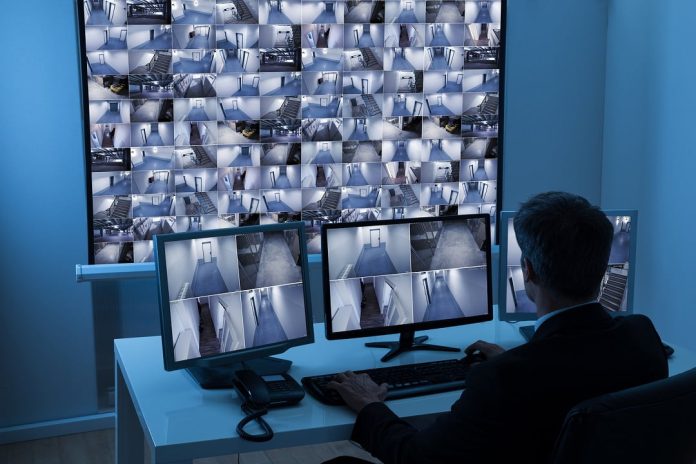Western Australia has released its State CCTV Strategy, setting out a vision for the shared use of integrated and compliant CCTV resources to enhance public safety and security in crime hotspots. The Strategy provides a framework for how the process will be achieved and in the future, face recognition and video analytics may be incorporated.
SHARING CCTV image streams is not without precedent but the State Government of Western Australia is taking this to another level, after unveiling plans for the state-wide integration of public and private CCTV resources in the interests of public safety and security by the end of 2017. It’s a bold vision that may well become a template, not just for other Australian states but for governments globally.
Importantly, this strategy has evolved over a decade or more. WA’s Blue Iris State Register for CCTV Owners in 2009, the creation of CCTV guidelines in 2011 and a code of practice in 2012, the integration of multiple systems and the establishment of a control room in Mayfield to handle CHOGM in 2011, the commitment to integrated CCTV solutions in the 2013 state elections – all these have been signposts on the journey. There was further support along the way in the findings of a report published by the WA Auditor General in 2011, which concluded that “there is potential to realise greater benefits through better sharing and more strategic use of CCTV information by the WA Police and local governments”.
Key steps in the process of implementing the Strategy include establishing a State CCTV Strategy Secretariat and the CCTV Advisory Panel, developing CCTV criteria, guidelines and procedures, re-building the existing State CCTV Register, exploring a Mobile Video Sharing solution, conducting a feasibility study and pilot for the connected CCTV solution, undertaking a staged implementation of the connected CCTV solution, reviewing, amending and drafting existing legislation and a series of funding rounds. These will deliver grants for the installation or upgrade of CCTV solutions across the state.
At the heart of the strategy is WA’s State CCTV Strategy Secretariat, to be part of WA Police, which will be responsible for executing the Strategy’s initiatives and will report to the Minister of Police. A CCTV Advisory Panel, comprising a chair from WA Police with membership expected to be comprised of representatives from government, peak bodies and industry, will also be established. It will be responsible for providing independent advice to the Minister on CCTV-related matters.
The State CCTV Strategy was unveiled recently by Liza Harvey MLA, WA’s Minister for Police; Road Safety; Training and Workforce Development and Women’s Interests. According to Harvey, advances in technology and the extent of CCTV uptake has provided the scope to improve the coordination of the use of CCTV to enhance public safety and assist law enforcement.

Liza Harvey MLA, WA’s Minister for Police; Road Safety; Training and Workforce Development and Women’s Interests
“In 2013, the Liberal-National Government made an election commitment to pioneer an integrated state CCTV network to assist in police tasking and fund additional cameras in crime hotspots,” said Harvey. “The State CCTV Strategy starts that journey by delivering the vision and framework toward a safer and more secure Western Australia. The Strategy outlines how state government, local government and private sector stakeholders can join together to manage their daily business, major events and incidents through effective use of smart CCTV technology.
“The Working Group, which was appointed in 2014 to deliver this Strategy, has proposed a solution that allows all CCTV owners in Western Australia to play their part in enhancing public safety by joining the State Register, while providing guidance to existing or future owners as to how best make use of existing or emerging technologies,” she said.
“Finally, the Strategy will develop the structure to harness technology which will allow for timely sharing of high value CCTV footage. Having improved access to high value CCTV footage will allow the police and other services to act more effectively and efficiently – not only through accessing traditional CCTV infrastructure, but also through better use of mobile technology.”
Implementation of the State CCTV Strategy
To ensure that delivery and risk is managed in an achievable way for the community, business and government, the strategic initiatives of the strategy will be implemented over 3 temporal horizons. Horizon 1 will run to the 2016/17 financial year with a focus on establishing the Strategy’s key foundations with feasibility studies conducted to explore the required technology solutions and updates made to legislation, policies and criteria to support the Strategy’s implementation.
Any required technology solutions will be built in Horizon 2, commencing in the 2015/16 financial year and running until the 2016/17 financial year. Once built, the technology solutions will then be scaled to suit ongoing operations. A review of this State CCTV Strategy will be conducted at the end of Horizon 2 when the required activities for Horizon 3 will be determined. It is also expected that Horizon 3 will pursue new opportunities identified following the implementation of Horizon 1 and Horizon 2, and may involve deepening technological capabilities through tools such as facial recognition and analytics to improve community safety and security outcomes.

Public space in centre of Perth
Connecting the State’s CCTV systems will be challenging, due to the diversity of system types, age and access restrictions. To circumvent this, the Strategy will prioritise registered CCTV system donors to identify those of the highest value for public safety. The Strategy also takes into account the fact that rapid development of CCTV technology may outpace the relevance and suitability of the documentation supporting the Strategy. The Taskforce will be responsible for reviewing and keeping documentation up to date. At all times, the Strategy’s progress and outcomes will be measured on behalf of the community and government to track that the aspiration of the State CCTV Strategy is achieved.
Operational fundamentals
Same as the rest of the world, leveraging the data gathered by CCTV cameras is hampered by technical challenges. There’s a multitude of proprietary systems and management solutions, a lack of technological expertise to operate discrete systems to retrieve footage, as well as a lack of consistency in how CCTV owners are approached to provide footage for investigative purposes. By facilitating better information sharing between donors and clients, the Strategy aims to accelerate investigation outcomes while reducing the impact of CCTV footage retrieval on daily operations.
The core of the Strategy is the provision of a mechanism by which CCTV owners can volunteer the data from any public facing camera that they manage to one or more agreed clients – typically law enforcement agencies like WA Police. When a CCTV system owner shares their data through the State CCTV Strategy, they are considered a donor. Anyone who receives data from a donor through the State CCTV Strategy is known as a client.
Everyone in WA has the opportunity to become a CCTV donor should they choose. Donors may be grouped into 3 broad categories, with each category being afforded a different way to participate. Government agencies will participate, business may choose to become registered, while members of the community may choose to become mobile-enabled via smart devices incorporating video cameras.

Perth, Western Australia
The State CCTV Strategy will facilitate data sharing in the following ways: On request data sharing for those donors recorded in the State Register, effective data sharing for donors who adopt the published leading practice criteria, guidelines or policies, real time and recorded data sharing for high value donors who become connected, or for mobile-enabled donors.
The State CCTV Register, which is currently called Blue Iris, will be refreshed to provide better functionality and operability for those CCTV owners who wish to voluntarily provide information about CCTV cameras that face public areas. The State CCTV Register will form a comprehensive database containing information on the State’s CCTV infrastructure and, in the event of an incident, WA Police and emergency services will be able to respond more effectively by obtaining CCTV system locations.
All client access to CCTV footage must be donor-approved. If connected, a legal agreement will be used by donors to formalise the terms of the donor-client relationship. The WA Police will always be the primary client, however, there is potential for other bodies (i.e. Local Government Authorities) to become a client if agreed by the CCTV owner and if they meet certain eligibility criteria.
Of the CCTV owners who register their infrastructure, it is expected that a small subset will have a large number of cameras covering public spaces. These owners will be encouraged on a case by case basis to become connected so that WA Police can directly access their live, and potentially recorded, CCTV footage for safety and security purposes. Other clients may be added if agreed by the CCTV owner and if they meet certain eligibility criteria.
A technology solution will be trialled and developed as part of the Strategy to connect these identified ‘high value’ CCTV owners. This connection will serve to minimise disruption to donor operations and increase police responsiveness to critical incidents.

Street crowds at Perth's Journey of Giants Festival
Mobile footage from the general public is included in the Strategy, which recognises that everyone with a smart phone or tablet now possesses a CCTV camera. As part of the Strategy, a Mobile Video Sharing solution will be tested to unlock this potentially rich source of data, providing a new way for citizens to contribute to WA’s safety and security.
Regular disruptions to CCTV owners who contribute data could discourage future participation and assistance. The State CCTV Strategy will support various avenues for community participation all of which have been designed to minimise the disruption on business operations or personal time. Where appropriate, a collaborative and integrated approach to retrieving footage will be employed to reduce duplication in efforts.
When footage of interest is identified, dissemination of the data is often obstructed when it is in a proprietary format. The Strategy will provide the community with guidance to ensure unifying technical formats that are simple and usable to facilitate data sharing. Meanwhile, clear guidelines for voluntary participation in the Strategy will be developed to emphasise that data sharing will only be allowed for supporting community safety and security initiatives and that commercial use of the data will not be allowed.
The most relevant privacy laws relating to the State CCTV Strategy include the Surveillance Devices Act (1998) WA, the Security and Related Activities (Control) Act (1996) WA and the Freedom of Information Act (1992) WA. Where appropriate, the criteria, policies and guidelines will also reflect how the existing legislation affects donor and client roles, rights and responsibilities.
The goals of the Strategy are clear. By coordinating the State’s CCTV assets, the Strategy will improve the ability of WA Police and other agencies to gather intelligence and respond to emergency situations in a more efficient and effective manner. Having access to a greater number of CCTV resources is expected to enhance the situational awareness of these agencies, improve their ability to allocate resources across multiple incidents, monitor crime hotspots and gather evidence for legal purposes.
There’s also the advantage of reduced fear of crime. Having CCTV cameras in public areas can act as a deterrent to potential offenders and gives community members confidence when going about their daily business. This likely reduction in fear of crime within the community will be enhanced by the Strategy, which coordinates footage from a range of sources to support improved policing outcomes. The Strategy will explore the option of having an appropriate mobile tool which enables the community to report crime and share footage of emergency situations.
Late last year, the WA State Government announced $5 million in grant funding for local governments to install CCTV cameras to help combat criminal and anti-social behaviour, and respond to emergencies. Police Minister Liza Harvey said the funding was a major plank of the Government’s State CCTV Strategy which would assist police and emergency services to access a greater number of CCTV security cameras across the State.
“The $5 million CCTV funding pool is now open for local governments to apply to either install CCTV cameras in crime hotspots, or upgrade existing infrastructure so it can feed into the network,” Harvey said. “This Government is committed to making communities safer through delivering tough laws and more police resources and CCTV has been a great tool for deterring, preventing and solving crime."
“The camera network will allow police and other authorised emergency services to access any CCTV system which is part of the network and view the footage being recorded.”
Harvey said a more integrated network could be a potential game changer in preventing and prosecuting crime and anti-social behaviour.
“This will work on several levels – police can assess crime jobs almost immediately, use the vision to prosecute offenders and deter criminal behaviour,” she said.♦
*Compiled by SEN staff – source Western Australia State CCTV Strategy
Potential CCTV donors in WA should contact:
State CCTV Strategy Secretariat:
WA Police Headquarters
2 Adelaide Terrace
East Perth WA 6004
cctv@police.wa.gov.au
61 8 9222 1267











